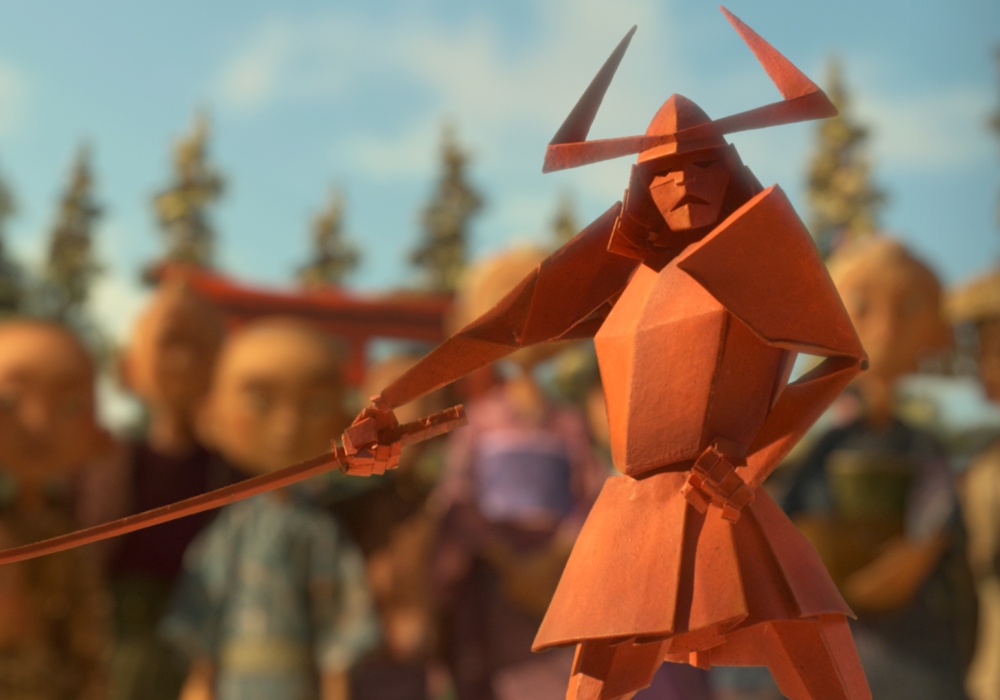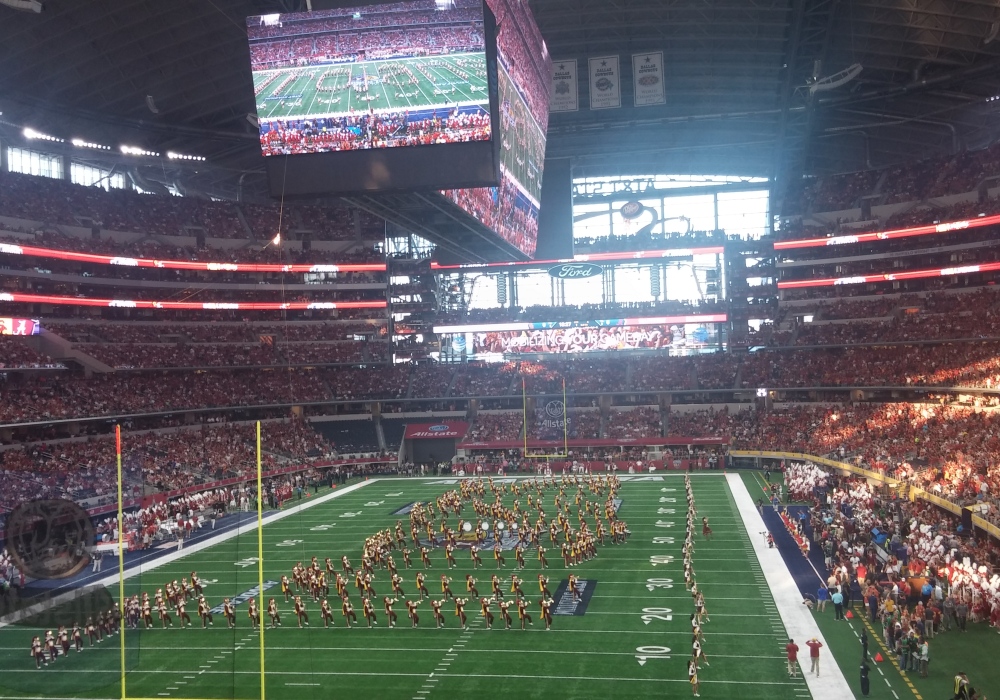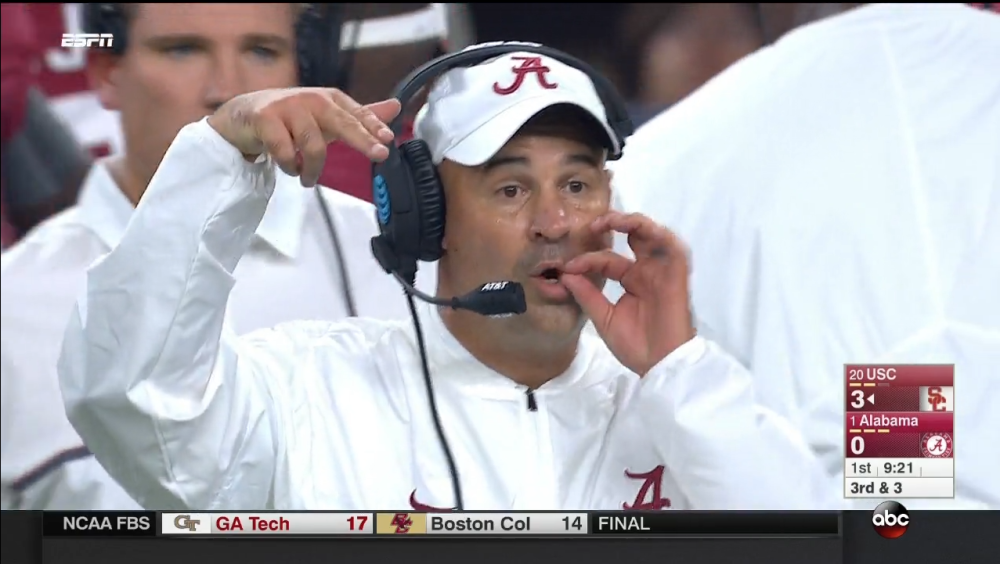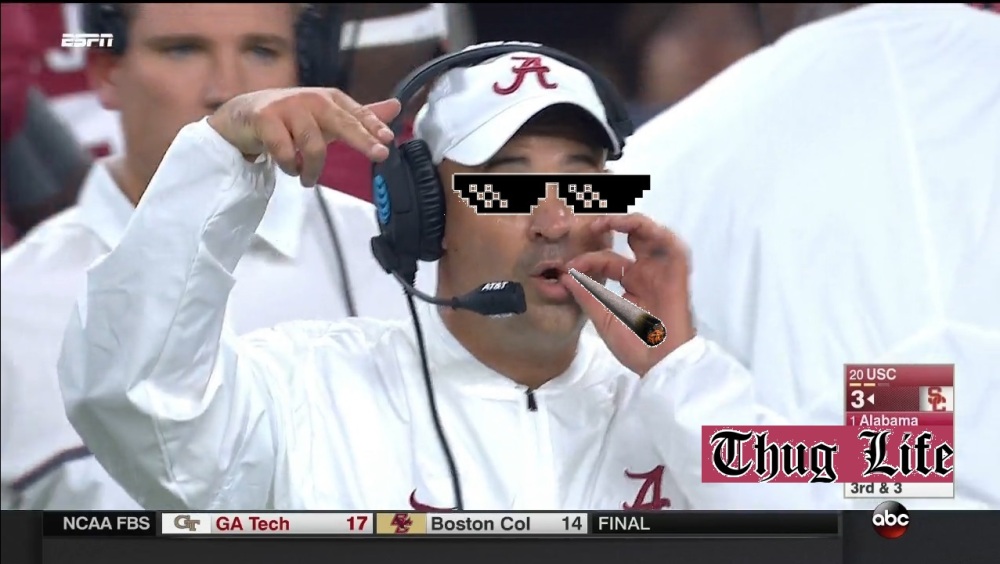
USC vs. Utah: All Fun Until Someone Fumbles
Utah vs. USC
September 23, 2016 at 7:05pm
Rice-Eccles Stadium, Salt Lake City, UT: 46,133 (45,807)
Total Time: 3 hours 21 minutes
A long season just got longer as the Trojans drop to 1-3 overall, 0-2 in the conference, and 0-1 in the Pac-12 South. We’ve all probably had our fill of the bad, so I won’t open with that. Make no mistake though, the bad will be covered—just later.
We’ll start with the best: Adoree’ Jackson deserves MVP for that game, even if he slipped at the end to allow the Utes’ go-ahead touchdown. He put life into the team with his 100-yard kickoff return for a touchdown on special teams. On defense, he broke up two passes and recovered a fumble. He also ran for 11 yards on a single carry on offense. Maybe he should go full-McCaffrey and throw for a TD too. No, please don’t.
Defensively, Cam Smith, Uchenna Nwosu, and Porter Gustin all played relatively well. Cam Smith compiled 6 tackles, 1 for a loss, and a fumble recovery in just the first quarter alone. Smith and Gustin also showed textbook discipline when defending the read option plays. That’s a welcome sight.
Offensively, the entire unit was much improved. Sure, the big storyline going into the game was the switch for Sam Darnold at quarterback. That certainly helped—he made some big time plays and kept some drives alive that Browne likely couldn’t have—but the supporting cast also stepped it up. Unfortunately, it was three weeks late and a few hundred thousand dollars short or however that saying goes. Sorry, let me stay on the positives…
The offensive line actually made a lot of blocks as a unit, allowing Justin Davis burst through the holes. Davis used his limited opportunities well, averaging 17 yards per carry in the first half and scoring his first touchdown of the season.
The pass protection was also mostly adequate, allowing Darnold time to find receivers open on a variety of routes. Then receivers and tight ends actually hung onto the ball, despite the rain. I don’t really remember there being many—if any—drops during that game. Players like Steven Mitchell and Tyler Petite have really shown themselves to be reliable pass-catchers. Tyler Petite might need some ballet lesson to help him with his balance though.
Darnold might’ve been the biggest bright spot on offense. He improved in terms of not straying in the pocket. He took decent scrambles, while remaining disciplined enough to go for available passes. So many athletic QBs just tuck and run at the first sign of trouble. Darnold clearly isn’t one of those. He fit some tough passes into tight windows while avoiding interceptions. I think I really only saw one or two bad throws from him this game. His scramble on the last play of the game was very Russell Wilson-esque (that’s a good thing).
Overall, the first half was relatively clean in terms of penalties. By some stroke of luck or a straight up voodoo magic, the team had one penalty for 5 yards. It did contribute to a stalled drive and settling for a field goal in the redzone, but oh well. I’ll take what I can get at this point. Now onward to the brave, new frontier of same old negatives for the team.
It was almost misleading to use the word “clean” to describe the first half. Despite averaging almost eight yards per play and not punting, they ended three of their own drives with fumbles. They were so close to adding a few more. Maybe it was the rain, maybe it was trying to do too much, but it just has to stop.
Then there was the penalties. Some of them were absolutely back-breaking. It wasn’t the free yardage that killed it, but rather the peripherals. I’ll intentionally leave names out because my purpose is to describe the effect rather than call out a player. For example, the team’s ineligible receiver downfield penalty only cost the offense 5 yards on paper. In reality though, it negated a 32-yard pass to Darreus Rogers. That 37-yard swing killed a drive. They punted without ever getting out of that set of downs. With the rise of RPOs (run-pass options) in college football, a greater emphasis has been placed on ineligible receiver downfield rules. Plays are packaged in a way that the quarterback can choose either a run ( can be set up as handoff or QB draw) or throw it to a receiver. That gets confusing not just for the defense, but for the offensive linemen as well. The result in this situation was a guard more than three yards down the field as if trying to make a run block. The NCAA considered this a big enough issue that they proposed changing the rule so that players are flagged at 1 yard out (like the NFL), rather than the current 3 yards. Instead of implementing the rule, they opted to emphasize that officials should call it. You can argue that it was a ticky-tack call, but unfortunately for USC, the refs were coached by the NCAA to look for it. Two years ago the Trojans probably could’ve gotten away with it.
Now that I’ve adequately waste your time with an entire 200 word paragraph on a single penalty, I can move on to the next costly penalty. It happened a flew plays later when Utah was 3rd-and-10 at their own 7-yard line. A Utah receiver was grabbed slightly out of his break by a USC corner, prompting a pass interference flag. The play quickly changed what likely would’ve been a three-and-out at the 7-yard line, to a 1st-and-10 at the 22. Quite the swing. They ultimately drove the entire 93 yards for the touchdown. It hurt that much more when it drained 5:29 of the remaining 5:45.
These two drives characterized the gulf between the two coaches. The difference can be hard to spot. You may be inclined to argue that the team was only a few plays away from turning it around. The problem actually started long before that. It’s about instilling a mentality in the players and team. It may sound cliche, but one team was playing not to lose and the other was playing to win. One rises to the occasion, the other wilts under pressure.
You run on a 3rd-and-6 to set up a 4th-and-3. That initially made me think they were playing that with a 4-down mentality. Instead, it was just a set up to settle for a field goal. Not too big of a deal in a vaccuum, I guess. On their next offensive possession, the pass to JuJu on 3rd-and-5 got spotted for 4th-and-3. Helton should have went for it. Instead, he elected to punt. Why? You just chose a short, 30-yard punt over the opportunity to put the game away.
You don’t need to look far back in the USC coaching history to find people that did that. Coach O took that shot when he put Arizona out of its misery and again against Stanford instead of punting for overtime. Even Steve Sarkisian tried it against Utah two years ago despite ultimately failing.
In the post game presser, the JuJu, speaking for the offense, said they even wanted to go for it. Denied the opportunity—again. Like against Stanford, Alabama, Oregon in 2015 and probably more that I’ve forgotten about.
The team lacks a killer instinct because the coach lacks one. Kyle Whittingham clearly did. His team went for it on 4th down a total of four times, going 4 for 4. On that final drive, he even did it twice and was vindicated.
I know this comes with the benefit of hindsight, but consider all the possibilities that stem from the choice to punt or go for it.
If they punt, there are really only three possible outcomes (especially with only one timeout left, but more on that later):
- Win, after the defense stops Utah (What Helton was “hoping” for from an ailing defense that generated 0 sacks and only 4 TFLs all game)
- Utah drains the clock and kicks a field goal to force overtime
- Utah drains the clock and wins it (what happened)
On the other hand, if they had gone for it:
- Convert and go for the eventual touchdown to win the game
- Convert and continue to drain the clock to win the game
- Fail and allow Utah the extra 30 yards from not punting
- Utah cannot drain the entire clock with a shorter field giving Helton and the team another chance to catch up if Utah scores
You’re putting your fate in your own hands in the second case. More of the latter outcomes look favorable, especially with the benefit of hindsight. Both in NFL and college football, rules favor the offense. A perfect offense would beat a perfect defense, if such things existed.
A perfect defense, USC was not. Before that final drive, USC had already allowed the second worst offense in the conference (statistically, at 26 ppg) to score 24 points. They somehow only managed to put up an average of 26 against Southern Utah, a weakened BYU, and San Jose State. At least USC, being the statisical worst offense in the conference (20.3 ppg) had some semblance of an excuse, having played #1 Alabama and #7 Stanford. That’s the defense he trusted. Speaking of trust:
Maybe he just misspoke, but officials are wrong all the time—even if they aren’t the terrible Pac-12 ones. The game moves fast, the guys are human. Why would you ever say that you trust them? It took me a careful review of the play to come to the conclusion that the spot was actually correct. Smith-Schuster made contact with the ball at the Utah 35-yard line, but did not establish his possession until one foot hit the ground at the Utah 37-yard line. Somehow though, he trusted that they got it right. It’s another thing if he said one of the coaches in the booth relayed that information, but, no, it was based on trust. Helton says a lot of things about trust and hope in regards to what’s happening on the field. I really hope that’s just semantics, but it really looks like he lacks a cohesive plan. Just winging it and hoping things bounce his way.
He will tell you that a few plays would’ve been the difference—that they would’ve won the game. Winning is a threshold, sure. That’s a big thing, no doubt.Had his team come out of the gates meeting even only a majority of their potential, this game would’ve been a blowout, not a barely achieved victory he couldn’t even get.
Rest of the bad:
- Fumbling on 3 of the 3 first drives and almost 4 of the first 4 had Darnold not sold the pass so well
- Allowing 12 straight run plays for a TD
- Ahead 24-10, averaging 8 yards per play, still can’t put the game away
- Taking out Justin Davis from the game when he was averaging over 12 yards per carry
- Still being too liberal with timeouts
And just so I don’t finish on a sour note,
Rest of the good:
- Being able to string together an 8 play, 91-yard drive for TD
- Going 6 for 10 on third down conversions
- Converting on 100% of field goals. Boermeester is 6 of 7 on field goals and 10/10 on PATs this season.
- Credit for not giving up after three fumbles, I guess
CommBro Breaker
After nearly two thousand words, you can have some easy to read snippets.
Morale Boosting Stat of the Week: USC #1 in the country in punt return yardage, averaging 40.25 yards per return
Misleading Stat of the Week: USC maintains its perfect record against unranked opponents. They also have a perfect record against G5 teams. Yeah, that’s 1-0 against Utah State on both counts.
Also, I’d like to announce that one of my favorite stats has increased by 1. I knew I started the count for a good reason!
Turnovers off of turnovers count: 2








